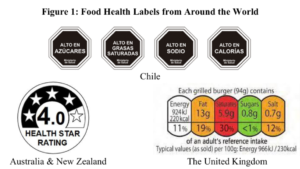
Food regulators in the United States should adopt smarter front-of-package labeling to encourage healthier eating.
Food consumption is a pre-requisite for human life. The last century, however, has brought about huge changes in the diets of most people in the developed world. Snacks, frozen food, fast food, fizzy drinks, and margarine did not exist for most of human history. Foods with sugar, an addictive and unhealthy ingredient, are readily available, cheap, and over-consumed. Overall, people are eating more processed food than ever before. Should regulators in the United States learn from other nations and attempt to improve front-of-package nutrition labels?
Unhealthy modern diets have been linked to a variety of negative health conditions. These include diabetes, heart disease, stroke, certain cancers, and the obesity epidemic. Indeed, food consumption is now posing a considerable risk to human life. It also has severe economic consequences.
Consider the United States, which has the highest levels of obesity. More than 65 percent of American adults are either overweight or obese. One in five children is likely to suffer from similar problems. In the United States alone, unhealthy diets contribute to approximately 678,000 deaths per year. The Centers for Disease Control and Prevention has estimated that further negative externalities, such as the costs imposed on public health systems, totalled $147 billion in 2008.
Acknowledging this problem, regulators around the world are mandating information disclosures, striving to arm consumers with valuable information. These disclosure requirements aspire to mandate clear and simple nutritional information, appearing prominently on the front packages of food products. Presumably, these disclosures should help consumers in making good nutritional choices.
In the United States and elsewhere, policymakers have mandated disclosures in the form of nutrition facts labels and lists of ingredients. However, there is a growing consensus that existing mandated disclosures have not been as effective as hoped.
Using nutrition labels and tables to address population health problems raises several issues. Many consumers do not pay proper attention to nutrition facts labels and list of ingredients. Some consumers may not have the necessary knowledge to read this information, nor the time or capacity to make the necessary computations based on it. Others may have the knowledge but not the time or motivation to do so. Yet others may exhibit over-optimism, mistakenly believing they are relatively immune from harm. Using fine print and hiding nutritional information in less noticeable places aggravates the problem.
To better inform consumers, regulators in some countries are experimenting with other, more novel, front-of-package labeling tools. Such tools are designed to improve communication with consumers, who often make purchasing decisions in a noisy environment. In such an environment, deliberate information processing is not likely to be the norm.
In this context, explicit front-of-package labels are presumed to be easier to notice, understand, and incorporate into consumers’ decision-making processes. They therefore nudge consumers into making healthier choices, while sparing them from the need to search for information, read it, and process it.
Labeling systems along these lines have been introduced in multiple countries and regions. These include, for instance, Australia and New Zealand, Chile, France, Scandinavian countries, and the United Kingdom. There are few front-of-package initiatives, however, in the United States, where legislators are less inclined to adopt, encourage, or facilitate pro-consumer initiatives.

True, current regulatory efforts in other countries are varied and partial in their scope. Yet, they may still serve as an important tool in assisting consumers to make healthier food choices. This is especially true if policymakers adopt a multidisciplinary evidence-based approach, continuously examining, evaluating, and improving such initiatives.
Manufacturers, marketers, distributors, and vendors have a strong profit-incentive to control consumers’ choices. It has thus been argued that the food industry is “hooking” consumers on unhealthy ingredients such as salt, sugar, and fat. The industry, according to this argument, deprives consumers of their money, health, and freedom to choose whatever food they want. Critics have also opined that food giants negatively impact other stakeholders.
One way or another, in the current environment, consumers find it hard to make unmanipulated, informed, and healthy choices. In essence, consumers are currently lacking an effective health signal on their foods and beverages.
With many Americans facing serious health, nutrition, and weight problems, U.S. regulators should expand the tools in their arsenal. They should do more to facilitate the display of front-of-package symbols or labels that provide pertinent and readily digestible information.
The essay is based on the authors’ article, “Hungry for Change: The Law and Policy of Food Health Labeling,” forthcoming in the Wake Forest Law Review.






